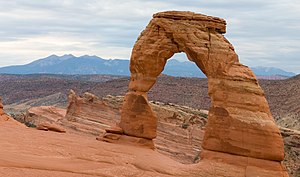

A natural arch, natural bridge, or (less commonly) rock arch is a natural landform where an arch has formed with an opening underneath. Natural arches commonly form where inland cliffs, coastal cliffs, fins or stacks are subject to erosion from the sea, rivers or weathering (subaerial processes).
Most natural arches are formed from narrow fins and sea stacks composed of sandstone or limestone with steep, often vertical, cliff faces. The formations become narrower due to erosion over geologic time scales. The softer rock stratum erodes away creating rock shelters, or alcoves, on opposite sides of the formation beneath the relatively harder stratum, or caprock, above it. The alcoves erode further into the formation eventually meeting underneath the harder caprock layer, thus creating an arch. The erosional processes exploit weaknesses in the softer rock layers making cracks larger and removing material more quickly than the caprock; however, the caprock itself continues to erode after an arch has formed, which will ultimately lead to collapse.
The choice between bridge and arch is somewhat arbitrary. The Natural Arch and Bridge Society identifies a bridge as a subtype of arch that is primarily water-formed.[1] By contrast, the Dictionary of Geological Terms defines a natural bridge as a "natural arch that spans a valley of erosion."[2]
The largest natural arch, by a significant margin, is the Xianren Bridge in China, with a span of 122 ± 5 meters (400 ± 15 ft).[3]
- ^ Natural Arch and Bridge Society Archived August 31, 2009, at the Wayback Machine, FAQ.
- ^ American Geological Institute, Dictionary of Geological Terms, 1976, Doubleday Anchor
- ^ Big 14 Tour - Fairy Bridge Archived April 20, 2017, at the Wayback Machine, The Natural Arch and Bridge Society